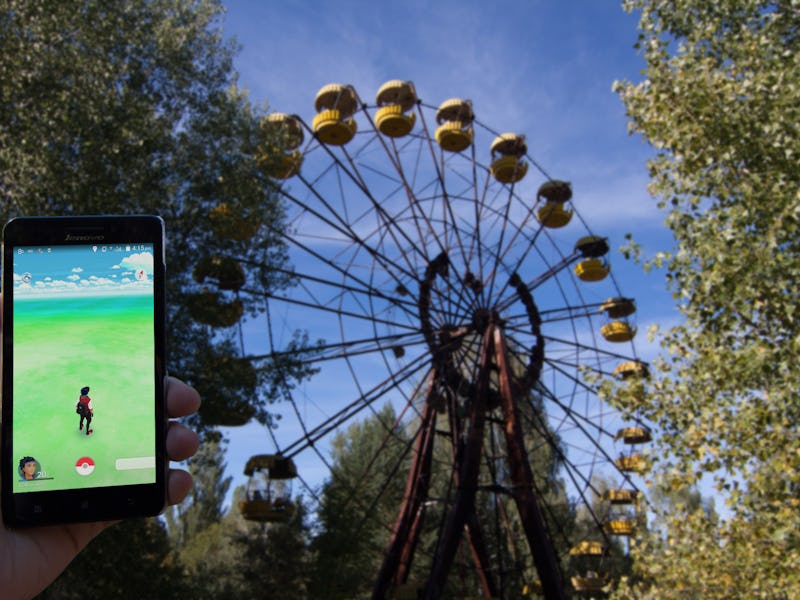You Can Play 'Pokémon Go' Inside the Chernobyl Exclusion Zone
Catch that radioactive Pidgey you've been wanting.

An area of the world where many humans fear to tread has a surprising new collection of residents. Pokémon have found their way inside the Chernobyl exclusion zone, the 18.6 mile-wide area surrounding the 1986 nuclear disaster. Travel writer Darmon Richter confirmed that, during a recent trip around eastern Europe, he was able to play Pokémon Go on an official tour of the zone.
“I found that there was nothing happening in the game inside the 10km Zone, the most radioactive area of Chernobyl which immediately surrounds the reactors and the abandoned city of Pripyat,” Richter tells Inverse. “Further out, however, in what’s known as the 30km Zone (a 30km radius from the reactors), the game was fully functional, with a large number of Pokéstops, gyms, and a range of spawning Pokémon.”
The revelation follows a July report on Japan’s Fukushima disaster site, the only other nuclear event rated 7 on the International Nuclear Event Scale. Both sites are subject to intense safety measures. Niantic, developer of Pokémon Go, worked with Tokyo Electric Power Company Holdings Co. to remove Pokéstops and in-game creatures from the three nuclear power sites. At the time, it was unclear whether Niantic had removed Pokéstops from other disaster sites fenced off from human life.
Inside the exclusion zone, Richter found that his GPS would stop working for extended periods. He believed a GPS jammer could be operating in the area, but it’s not certain. Previous reports suggest that teenagers trespassing into the most radioactive areas — a group that calls themselves “stalkers” — use satellite navigation to explore the abandoned areas.
In other areas of the zone, Richter found a world void of Pokémon. In many ways, it reflects reality: Pripyat is a ghost town. Formerly home to over 50,000 people, today the crumbling wreckage captures a distant memory of the USSR’s grandest hopes for the future. Experts believe that, owing to the extreme levels of radiation, humans will not be able to reside in Pripyat for the foreseeable future.
The nearby Chernobyl New Safe Confinement is a multi-billion dollar engineering feat designed to contain the reactor’s radiation for the next 100 years. Hans Blix, the Swedish diplomat in charge of the International Atomic Energy Agency at the time of the disaster, told Inverse that he never believed such a structure was possible. “It was inconceivable then,” he said. “My only thought was ‘what a horrible tragedy this is.’”
Although the creatures won’t appear in the near vicinity of the disaster, Chernobyl’s exclusion zone stretches far. The 30km zone, the outermost evacuated area, is home to around 180 people, mainly elderly residents that have chosen to remain despite the radiation levels.
“Opinions differ on exactly how dangerous the 30km Zone is, but most would agree that it’s not somewhere you’d want to live,” Richter says. “In that respect, you could definitely say that the game encourages play in a dangerous area.”
Inverse reached out to Niantic to find out whether they agreed the game encourages unsafe behavior, but the developer had not responded at the time of publication.
Former landmarks have taken on new life as virtual points to stock up on supplies. The above Lenin statue is one of the last still standing in Ukraine: although the country underwent a period of de-Sovietization after the fall of communism, there was a renewed push to remove the remaining Lenin statues during the 2014 revolution. There were 5,500 Lenin statues in Ukraine at the time of the USSR’s breakup: by the end of 2015, that number had dropped to 1,300. Today, the leader of the Russian revolution doles out Pokéballs, promoting one of capitalism’s most recognizable franchises.
The haunting backdrop to Richter’s game would have been weird enough, but then he got some unwelcome attention. One night, playing in the Chernobyl town, he captured a gym at the “third angel” monument. “It was absolute pitch black that night, no street lights, and dark enough that I managed to get quite lost as I played,” he says.
As he wandered around the darkened paths, Richer realized he’d walked in a circle. He peered at the game, saw his gym and froze. “Another player had already captured it… meaning that someone else was with me, wandering around in the darkness in this largely abandoned town in Chernobyl,” Richter says.
“Chernobyl” has become an instantly recognized slang word in English. A catastrophe. A defining moment for the USSR. A cautionary tale about nuclear energy. But Pokémon Go washes all that away, with a pristine map and virtual creatures untouched by the invisible poison. The game is the same in Chernobyl as it is elsewhere, but players still fire up the game in obscure locations. In that little five-inch window, players glimpse a world void of history and its horrors. With the radiation infecting life around it, it’s a luxury Chernobyl may never truly afford.